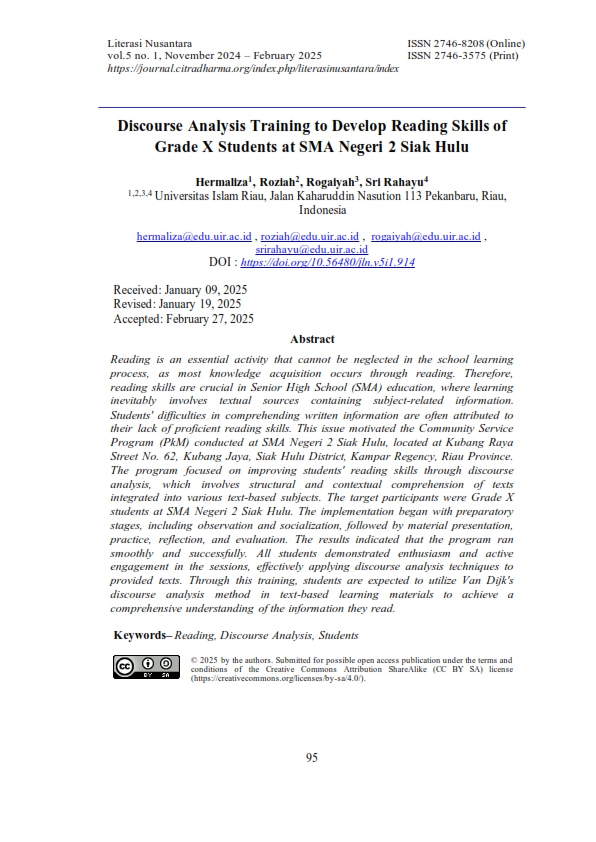Discourse Analysis Training to Develop Reading Skills of Grade X Students at SMA Negeri 2 Siak Hulu
DOI:
https://doi.org/10.56480/jln.v5i1.914
 Abstract View:
Abstract View:
41
 PDF downloads:
PDF downloads:
50
Keywords:
Reading, Discourse Analysis, StudentsAbstract
Reading is an essential activity that cannot be neglected in the school learning process, as most knowledge acquisition occurs through reading. Therefore, reading skills are crucial in Senior High School (SMA) education, where learning inevitably involves textual sources containing subject-related information. Students' difficulties in comprehending written information are often attributed to their lack of proficient reading skills. This issue motivated the Community Service Program (PkM) conducted at SMA Negeri 2 Siak Hulu, located at Kubang Raya Street No. 62, Kubang Jaya, Siak Hulu District, Kampar Regency, Riau Province. The program focused on improving students' reading skills through discourse analysis, which involves structural and contextual comprehension of texts integrated into various text-based subjects. The target participants were Grade X students at SMA Negeri 2 Siak Hulu. The implementation began with preparatory stages, including observation and socialization, followed by material presentation, practice, reflection, and evaluation. The results indicated that the program ran smoothly and successfully. All students demonstrated enthusiasm and active engagement in the sessions, effectively applying discourse analysis techniques to provided texts. Through this training, students are expected to utilize Van Dijk's discourse analysis method in text-based learning materials to achieve a comprehensive understanding of the information they read.
References
Alpian, V. S., & Yatri, I. (2023). Analisis Kemampuan Membaca Permulaan dan Kesulitan yang dihadapi Siswa Kelas 1 Sekolah Dasar. Jurnal Lensa Pendas, 8(2), 113–122. https://doi.org/10.33222/jlp.v8i2.2818
Andriana, M., & Manaf, N. A. (2022). Analisis Wacana Kritis Sara Mills dalam Novel Berkisar Merah Karya Ahmad Tohari. Deiksis, 14(1), 73. https://doi.org/10.30998/deiksis.v14i1.9961
Arwita Putri, Riris Nurkholidah Rambe, Intan Nuraini, Lilis Lilis, Pinta Rojulani Lubis, & Rahmi Wirdayani. (2023). Upaya Peningkatan Keterampilan Membaca Di Kelas Tinggi. Jurnal Pendidikan Dan Sastra Inggris, 3(2), 51–62. https://doi.org/10.55606/jupensi.v3i2.1984
Djokowidodo, A., & Dani, A. (2020). Jurnal Sastra Indonesia Psikopragmatik Dalam Tuturan Wacana Iklan : 9(15), 151–157. https://doi.org/10.15294/jsi.v9i3.42542
Dwisda, R. E. (2023). Analisis Wacana Kritis Bagian TED-TALK Video: Manfaat Kesehatan Belajar Bahasa Asing oleh Daria Zaikovskaia. JIIP - Jurnal Ilmiah Ilmu Pendidikan, 6(5), 3315–3317. https://doi.org/10.54371/jiip.v6i5.1741
Eriyanto. (2011). Analisis Wacana: Pengantar Analisis Teks Media. LKIS.
Fauziah, H., & Hidayat, M. T. (2022). Efektivitas Penggunaan Aplikasi Belajar ”Ayo Belajar Membaca” dan ”Marbel Membaca” pada Siswa Sekolah Dasar. Jurnal Basicedu, 6(3), 4825–4832. https://doi.org/10.31004/basicedu.v6i3.2944
Muawanah, M., & Watini, S. (2022). Implementasi Model Asyik Dalam Meningkatkan Kemampuan Membaca Di RA Al-Fikri Kota Batam. Aksara: Jurnal Ilmu Pendidikan Nonformal, 8(3), 1905. https://doi.org/10.37905/aksara.8.3.1905-1914.2022
Muhaimin, M. R., Ni’mah, N. U., & Listryanto, D. P. (2023). Peranan Media Pembelajaran Komik Terhadap Kemampuan Membaca Siswa Sekolah Dasar. Jurnal Pendidikan Dasar Flobamorata, 4(1), 399–405. https://doi.org/10.51494/jpdf.v4i1.814
Ndruru, M., Harefa, T., & Harefa, N. A. J. (2022). Penerapan Model Pembelajaran Cooperative Script Dalam Meningkatkan Kemampuan Membaca Intensif Siswa. Educativo: Jurnal Pendidikan, 1(1), 96–105. https://doi.org/10.56248/educativo.v1i1.14
Nuriadi. (2008). Teknik Jitu menjadi Pembaca Terampil. Pustaka Pelajar.
Rahma, R., Utomo, A. P. Y., & Sumarlam. (2022). Wacana Kritik Pandemi dalam Meme Instagram dan Pemanfaatannya sebagai Materi Ajar Membaca Kritis di Perguruan Tinggi. Jurnal Sastra Indonesia, 11(2), 139–151. https://doi.org/10.15294/jsi.v11i2.55296
Rahmaniar, S., Amir, J., Jufri, & Thaba, A. (2021). Representasi Ideologi dan Kekuasaan Teks Berita Virus Corona (Analisis Wacana Kritis Roger Fowler, Dkk.). JP-BSI: Jurnal Pendidikan Bahasa Dan Sastra Indonesia, 6(2), 76–81.
Razak, A. (2015). Membaca Pemahaman: teori dan aplikasi pengajaran. Ababil Press.
Rosita, I., & Syahadah, D. (2019). Referensi Endofora dalam sebuah Cerpen “ Aku Cinta Umi Karena Allah ” Karya Jenny. 1(1).
Setiawan, K. E. P., Arwansyah, Y. B., & Sumarlam. (2022). Jurnal Sastra Indonesia 11 (2) (2022) 92-99 Jurnal Sastra Indonesia Analisis Wacana Kritis Berita Daerah Ngawi dalam Media Daring radarmadiun.co.id Edisi Oktober 2021. Jurnal Sastra Indonesia, 11(2), 92–99. https://doi.org/10.15294/jsi.v11i2.56189
Suharya, S., Wardarita, R., & Misriani. (2019). ANALISIS WACANA KRITIS DALAM KUMPULAN PIDATO PRESIDEN REPUBLIK INDONESIA KE-7 Ir. JOKO WIDODO. Jurnal Pembahsi (Pembelajaran Bahasa Dan Sastra Indonesia), 9(1), 47–57. https://doi.org/10.31851/pembahsi.v9i1.4244
Sultan. (2018). Membaca Kritis: mengungkap ideologi dengan pendekatan literasi kritis. Baskara Media.

Downloads
Published
How to Cite
License
Copyright (c) 2024 Hermaliza, Roziah, Rogaiyah, Sri Rahayu

This work is licensed under a Creative Commons Attribution-ShareAlike 4.0 International License.
Copyright Notice
Authors who publish with this journal agree to the following terms:
- Authors retain copyright and grant the journal right of first publication with the work simultaneously licensed under a Creative Commons Attribution-ShareAlike 4.0 International License that allows others to share the work with an acknowledgment of the work's authorship and initial publication in this journal.
- Authors are able to enter into separate, additional contractual arrangements for the non-exclusive distribution of the journal's published version of the work (e.g., post it to an institutional repository or publish it in a book), with an acknowledgment of its initial publication in this journal.
- Authors are permitted and encouraged to post their work online (e.g., in institutional repositories or on their website) prior to and during the submission process, as it can lead to productive exchanges, as well as earlier and greater citation of published work (See The Effect of Open Access).

This work is licensed under a Creative Commons Attribution-ShareAlike 4.0 International License.





























